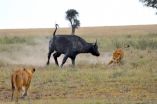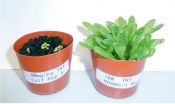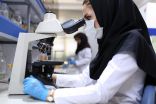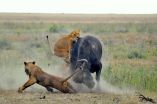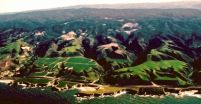How dusty or dairy farm air protect against allergies
2015-09-03
(Press-News.org) This news release is available in Japanese.
Regular exposure to bacteria particles and farm dust protects children from allergies because it blunts their inflammatory immune responses, a new mouse study suggests. The study implicates a particular anti-inflammatory enzyme, A20, in this protective effect. While aspects of how allergies develop remain unclear, scientists know they're driven not only by genes but also by environment. Homes with pets, as well as dairy farms - where children breathe dust containing higher doses of fungal particles, cowshed-derived bacteria and the bacterial component endotoxin - defend against allergies, recent studies suggest, yet just how has remained elusive. Now, Martijn J. Schuijs et al. shed light on this mystery. The researchers exposed mice to endotoxin every other day for two weeks. They then presented these mice with allergy-driving house dust mites, which often cause asthma in people, finding that mice that had been regularly exposed to endotoxin did not develop allergic features, while control mice did. Endotoxin exposure appears to have protected the mice by squashing the ability of the animals' lung epithelial cells to generate pro-inflammatory molecules, though this protective effect only worked in the presence of a good copy of the enzyme A20. To confirm that A20 had to be functional for the protective effect to work, the researchers turned to humans, using lung biopsy samples from healthy adults and asthmatics. After regular exposure to endotoxin, healthy human cells generated fewer inflammatory molecules characteristic of allergies than their asthmatic counterparts, in whom A20 levels were also lower. This suggests that farming and other similar environments protect against allergy with this enzyme's help.
INFORMATION:
Article #15: "Farm dust and endotoxin protect against allergy through A20 induction in lung epithelial cells," by M.J. Schuijs; M.A. Willart; K. Vergote; K. Deswarte; F.B. Madeira; R. Beyaert; G. van Loo; B.N. Lambrecht; H. Hammad at VIB Inflammation Research Center in Ghent, Belgium; M.J. Schuijs; M.A. Willart; K. Vergote; K. Deswarte; F.B. Madeira; R. Beyaert; G. van Loo; B.N. Lambrecht; H. Hammad at Ghent University in Ghent, Belgium; D. Gras; P. Chanez at INSERM in Marseille, France; D. Gras; P. Chanez at CNRS in Marseille, France; D. Gras; P. Chanez at Aix Marseille University in Marseille, France; M.J. Ege; E. von Mutius at Dr. von Hauner Children's Hospital in Munich, Germany; M.J. Ege; E. von Mutius; F. Bracher at Ludwig-Maximilians-Universität in Munich, Germany; B.N. Lambrecht at Erasmus University Medical Center in Rotterdam, Netherlands.
ELSE PRESS RELEASES FROM THIS DATE:
2015-09-03
This news release is available in Japanese.
Ecological communities around the world are richly varied, but a new study finds that many of these diverse communities follow an unexpected, yet consistent pattern: where prey are abundant, there are not proportionally more predators. Instead, as prey biomass increases, the ratio of predator-to-prey biomass decreases. This pattern was systematically identified across different areas, including grasslands, forests, lakes, and oceans, revealing an underlying structural organization of ecosystems. Pinpointing underlying ...
2015-09-03
This news release is available in Japanese.
Researchers have identified a mutation in plants that allows them to break down TNT, an explosive that has become highly prevalent in soil in the last century, particularly at manufacturing waste sites, mines, and military conflict zones. TNT, or 2,4,6-trinitrotoluene, is a toxic and persistent environmental pollutant that accumulates in the roots of plants, inhibiting growth and development. The identification of a plant mechanism that not only evades the negative impacts of TNT, but breaks down this harmful substance could ...
2015-09-03
This news release is available in Japanese.
A special news edition, Science in Iran, looks closely at the scientific challenges and triumphs of a country that has faced international isolation in recent years. Following an exclusive interview about the Iran nuclear deal with Ali Akbar Salehi, president of the Atomic Energy Organization of Iran, Science International News Editor Richard Stone delves further into the state of Iran's scientific endeavors. Decades of economic sanctions have deprived Iranian scientists of critical scientific resources and collaboration. ...
2015-09-03
Biologists at the University of York have taken an important step in making it possible to clean millions of hectares of land contaminated by explosives.
A team from the Centre for Novel Agricultural Products (CNAP) in the University's Department of Biology has unravelled the mechanism of TNT toxicity in plants raising the possibility of a new approach to explosives remediation technology. TNT has become an extensive global pollutant over the last 100 years and there are mounting concerns over its toxicity to biological systems.
The study, which is published in Science, ...
2015-09-03
Researchers at VIB (a leading life sciences institute in Flanders, Belgium) and Ghent University have successfully established a causal relationship between exposure to so-called farm dust and protection against asthma and allergies. This breakthrough discovery is a major step forward towards the development of an asthma vaccine. The results of the research were published in the leading journal Science.
It is commonly known that drinking raw cow's milk can provide protection against allergies. A 14-member research team, led by professors Bart Lambrecht and Hamida Hammad ...
2015-09-03
Evidence from a new study published in PLOS Computational Biology by researchers from Brown University and led by Assistant Professor Thomas Serre suggests that when we analyze scenery we simply make the easiest judgments first, rather than following a priority order of categories.
There are many ways we understand scenery. Is it navigable or obstructed? Natural or man-made? A face or not a face? In previous experiments, researchers have found that some categorization tasks seem special, in that they occur earlier than others, leading to a hypothesis that the brain has ...
2015-09-03
Rodents huddle together when it is cold, they separate when it is warm, and at moderate temperatures they cycle between the warm center and the cold edges of the group. In a new study published in PLOS Computational Biology, Jonathan Glancy, Roderich Gross, Jim Stone and Stuart Wilson from the University of Sheffield found they could simulate huddling by assuming simply that touching individuals in turn brings their temperatures closer to an ideal body temperature. According to the model, these selfish individual behaviours improved the ability of the whole group to regulate ...
2015-09-03
Why aren't there more lions? That was what puzzled McGill PhD student Ian Hatton, when he started looking at the proportion of predators to prey across dozens of parks in East and Southern Africa. In this case, the answer had nothing to do with isolated human hunters. The parks were teeming with potentially tasty treats for the lions. So one might imagine that the population of lions in each park would increase to match the available prey. Instead, what Hatton and the McGill-led team discovered was that, in a very systematic way, in crowded settings, prey reproduced less ...
2015-09-03
CAMBRIDGE, Mass. (September 3, 2015) - A protein known to play a role in transporting the molecular contents of normal cells into and out of various intracellular compartments can also turn such cells cancerous by stimulating a key growth-control pathway.
By conducting a large-scale search for regulators of the signaling pathway known as PI3K/AKT, which promotes cell survival, growth, and proliferation--and which is highly active in cancer cells--researchers at Whitehead Institute and Memorial Sloan-Kettering Cancer Center have implicated the protein RAB35 in the oncogenic ...
2015-09-03
For millions of years, the Pacific and North American plates have been sliding past -- and crashing into -- one another. This ongoing conflict creates uplift, the geological phenomenon that formed mountains along the west coast.
A new analysis by UC Santa Barbara earth scientist Alex Simms demonstrates that the Pacific coastlines of North America are not uplifting as rapidly as previously thought. The results appear in the journal Geological Society of America Bulletin.
"Current models overestimate uplift rates by an average of 40 percent," said Simms, an associate ...
LAST 30 PRESS RELEASES:
[Press-News.org] How dusty or dairy farm air protect against allergies
